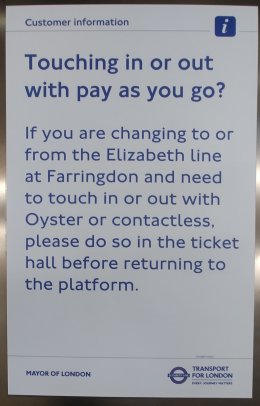Roland Perry
2022-07-05 10:27:44 UTC
Mainly about the eastern side (surface building 23 Long Lane, which is
consistent with the building next door being signed 18-19; a mystery why
#66 also turns up on Google). Looking west along Long Lane:
Loading Image...
The name over the doors(s) is Farringdon, and there are sliding doors
facing both Long Lane and the side-roads, although so far they only
appear to use the side-road opening. Note the duplicate "No Entry" and
Farringdon" signage facing Long Lane.
Down at platform level there are signs indicating which end of the
platform to use if wanting either Farringdon Tube/National Rail, or
Barbican (the complex, not the station).
htp://www.perry.co.uk/images/Farringdon-PlatformSign.jpg
Starting afresh from EL platform level looking up (southeast), there are
two similar-length banks of escalators, with an 'Interchange' (aka
mezzanine) level. Each bank has an inclined lift on the left parallel
with the escalators.
The famous "secret lift" [G] is in a lobby off the left of the
Interchange Level, and here's the layout diagram inside the upper
inclined lift:
Loading Image...
Aside: it's not obvious why the upper bank has an inclined lift, rather
than a vertical one with horizontal passages top and/or bottom. Like at
Kings Cross Northern Ticket Hall. Unless they wanted symmetry, or
there's something under the surface in the way (which is one suggestion
for needing the lower inclined lift).
The secret lift-G is a shorter trip that I was expecting, but that's
explained by the upper entrance being on a sub-surface platform. And
which of course pinpoints where the Interchange level is (directly under
the western end of the Barbican station platforms). Being as far as it's
possible to get from the Barbican ticket office, the lift isn't
something most people would notice.
Meanwhile, back at the western end of the station, the "passage" with
'missing' validators is very short, with the Northbound Thameslink
trains right in front of you, and is more of an extension to the final
intermediate (almost at the top) concourse. There's a sign on the wall:
Loading Image...
For symmetry with other parts of the station I can't help feeling a
gateline there would be more intuitive for the passengers. Even if it
means a redundant touch for many passengers. My recollection is that one
of the earlier double-ended stations (Southwark, Jubilee Line) has one
if you want to exit onto Blackfriars Road, via the tube station, having
arrived at Waterloo East National Rail, .
consistent with the building next door being signed 18-19; a mystery why
#66 also turns up on Google). Looking west along Long Lane:
Loading Image...
The name over the doors(s) is Farringdon, and there are sliding doors
facing both Long Lane and the side-roads, although so far they only
appear to use the side-road opening. Note the duplicate "No Entry" and
Farringdon" signage facing Long Lane.
Down at platform level there are signs indicating which end of the
platform to use if wanting either Farringdon Tube/National Rail, or
Barbican (the complex, not the station).
htp://www.perry.co.uk/images/Farringdon-PlatformSign.jpg
Starting afresh from EL platform level looking up (southeast), there are
two similar-length banks of escalators, with an 'Interchange' (aka
mezzanine) level. Each bank has an inclined lift on the left parallel
with the escalators.
The famous "secret lift" [G] is in a lobby off the left of the
Interchange Level, and here's the layout diagram inside the upper
inclined lift:
Loading Image...
Aside: it's not obvious why the upper bank has an inclined lift, rather
than a vertical one with horizontal passages top and/or bottom. Like at
Kings Cross Northern Ticket Hall. Unless they wanted symmetry, or
there's something under the surface in the way (which is one suggestion
for needing the lower inclined lift).
The secret lift-G is a shorter trip that I was expecting, but that's
explained by the upper entrance being on a sub-surface platform. And
which of course pinpoints where the Interchange level is (directly under
the western end of the Barbican station platforms). Being as far as it's
possible to get from the Barbican ticket office, the lift isn't
something most people would notice.
Meanwhile, back at the western end of the station, the "passage" with
'missing' validators is very short, with the Northbound Thameslink
trains right in front of you, and is more of an extension to the final
intermediate (almost at the top) concourse. There's a sign on the wall:
Loading Image...
For symmetry with other parts of the station I can't help feeling a
gateline there would be more intuitive for the passengers. Even if it
means a redundant touch for many passengers. My recollection is that one
of the earlier double-ended stations (Southwark, Jubilee Line) has one
if you want to exit onto Blackfriars Road, via the tube station, having
arrived at Waterloo East National Rail, .
--
Roland Perry
Roland Perry